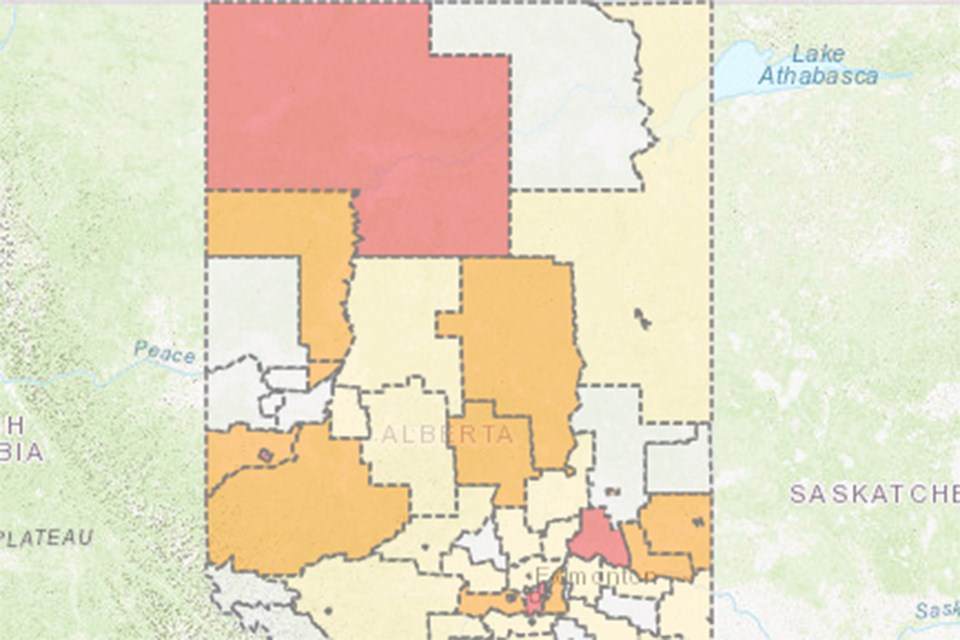Communities in rural northern Alberta are seeing higher rates of COVID-19 infections relative to their population than the province's two biggest cities.
In the last month, rural Alberta communities saw R-values – the average number of people infected by one person with COVID-19 – reach higher rates than Edmonton and Calgary. The rate of spread in rural communities has since come in line with the rest of the province, but northern Alberta is still struggling to get cases down.
In the past few weeks, active cases in the northern health region have almost doubled. About two weeks ago, the North zone reported 737 active cases of COVID-19. As of Wednesday, there are 1,009 active cases in the North zone, marking a 36 per cent increase.
Alberta Premier Jason Kenney said while the eastern side of the province has done well keeping the number of active cases down, the northeast quadrant of the province is seeing a spike.
"In the northeast quadrant of the province, which is one half of the North health zone, we certainly see very significant increases," Kenney said.
As of Monday, Smoky Lake County, located an hour and 45 minutes north east of Edmonton, had the highest rate of infection per 100,000 people. That means if the community had a population of 100,000, about 1,635 people would have tested positive for COVID-19. The community of 8,378 people currently has 137 cases of the virus.
The Municipal District Of Opportunity, located three hours north of Edmonton, has the second highest rate with 1,197.5 cases per 100,000, which irons out to 79 cases in the community of 6,597.
Mackenzie County, located almost seven hours north east of Edmonton, has 930.6 cases per 100,000, or 228 cases in a community with 24,499. The County of Northern Lights, located in the far north west corner of the province, has 375.1 cases per 100,000, or 14 active cases in the community of 3,733 residents.
Grande Prairie, the largest city in northwest Alberta, has the 11th highest COVID-19 rate per 100,000. The city currently has 209 cases per 100,000, or 217 cases in the community of 74,245.The premier said he has asked for more information about what exactly may be contributing to the high numbers in these communities.
One unfortunate contributing factor is there have been several outbreaks in First Nation communities, Kenney said, despite these communities showing exceptional leadership in following COVID-19 health regulations.
"We have heard some reports of social activity that may have caused transmission. So, we are renewing our call to First Nations leadership and communities to work with our public health authorities to make sure that people are doing everything they can to comply with the measures," Kenney said.
Outbreaks of COVID-19 in these communities is another contributing factor, with at least four outbreaks reported at senior care facilities in the Grande Prairie area.
Kenney asked those living in the region and across the province to continue to comply with public health measures.
"What matters here is not simply the stringency of public health measures, but also the willingness of people to comply with them," Kenney said. "We would just encourage people in every part of the province to take these measures seriously."
In February, Alberta Chief Medical Officer of Health Dr. Deena Hinshaw said there is a perception that rural Alberta has fewer cases of COVID-19, but that is not the case.
"At the moment, (the) North zone has the highest active case rate of COVID-19 in the province of all five of the zones," Hinshaw said.
There are several municipalities in the North zone with very high active cases, Hinshaw said. The Central zone has roughly the equivalent to Calgary right now in terms of active cases per 100,000.
"In both North zone and Central zone, we've actually had an uptick in our new case numbers in the last week or so," Hinshaw said.
Hinshaw said Alberta Health will continue to take a province-wide approach to reopening rather than a regional one.
"If we do choose to ease restrictions faster in one area of the province, there is a risk that in the locations where we're seeing higher transmission, you could have people traveling from a higher transmission area to a lower transmission area; it could actually cause risk in those locations where there's more activities permitted."
Read more from StAlbertToday.ca



